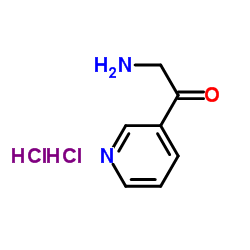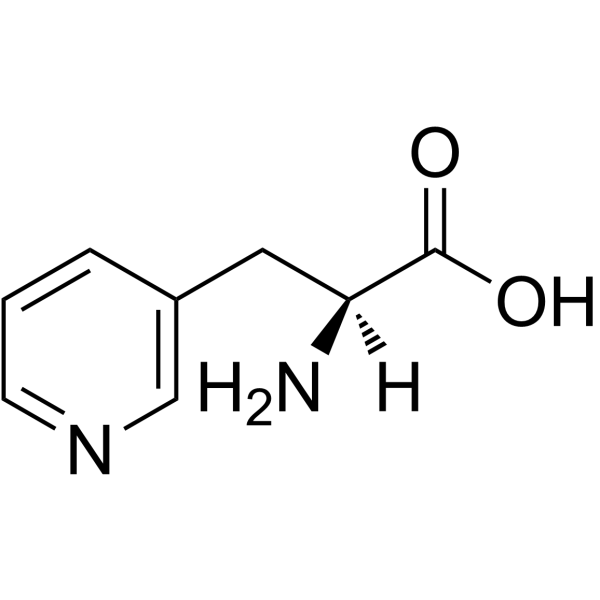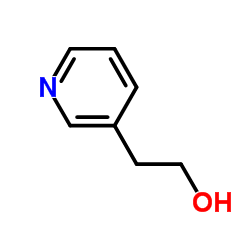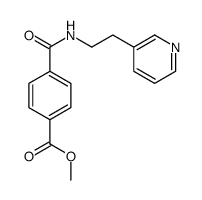20173-24-4
| 中文名 | 3-(2-氨基乙基)吡啶 |
|---|---|
| 英文名 | 2-pyridin-3-ylethanamine |
| 中文别名 |
3-(2-氨乙基)吡啶
2-(3-吡啶基)乙胺 |
| 英文别名 |
2-(3-Pyridinyl)ethanamine
3-aminoethyl pyridine 3-Pyridineethanamine MFCD00191604 3-PYRIDINEETHANEAMINE 2-(pyridin-3-yl)ethanamine 2-pyridine-3-yl-ethyl amine 3-(2-Aminoethyl)pyridine 2-(3-Pyridyl)ethylamine |
| 密度 | 1.0±0.1 g/cm3 |
|---|---|
| 沸点 | 228.8±15.0 °C at 760 mmHg |
| 分子式 | C7H10N2 |
| 分子量 | 122.168 |
| 闪点 | 112.8±7.4 °C |
| 精确质量 | 122.084396 |
| PSA | 38.91000 |
| LogP | -0.03 |
| 蒸汽压 | 0.1±0.5 mmHg at 25°C |
| 折射率 | 1.541 |
| 储存条件 | 保持贮藏器密封 放入紧密的贮藏器内,储存在阴凉,干燥的地方 |
| 稳定性 | 如果遵照规格使用和储存则不会分解 避免接触 氧化物,酸 |
| 分子结构 | 五、分子性质数据: 1、 摩尔折射率:37.42 2、 摩尔体积(m3/mol):119.1 3、 等张比容(90.2K):307.0 4、 表面张力(dyne/cm):44.1 5、 极化率(10-24cm3):14.83 |
| 计算化学 | 1.疏水参数计算参考值(XlogP):无 2.氢键供体数量:1 3.氢键受体数量:2 4.可旋转化学键数量:2 5.互变异构体数量:无 6.拓扑分子极性表面积38.9 7.重原子数量:9 8.表面电荷:0 9.复杂度:73.3 10.同位素原子数量:0 11.确定原子立构中心数量:0 12.不确定原子立构中心数量:0 13.确定化学键立构中心数量:0 14.不确定化学键立构中心数量:0 15.共价键单元数量:1 |
| 更多 | 1.性状:未确定 2.密度(g/mL,25/4℃):1.04 3.相对蒸汽密度(g/mL,空气=1):未确定 4.熔点(ºC):未确定 5.沸点(ºC,常压):119-120°C 19mm 6.沸点(ºC,5.2kPa):未确定 7.折射率:1.5518 8.闪点(ºC):119-120°C/19mm 9.比旋光度(º):未确定 10.自燃点或引燃温度(ºC):未确定 11.蒸气压(kPa,25ºC):未确定 12.饱和蒸气压(kPa,60ºC):未确定 13.燃烧热(KJ/mol):未确定 14.临界温度(ºC):未确定 15.临界压力(KPa):未确定 16.油水(辛醇/水)分配系数的对数值:未确定 17.爆炸上限(%,V/V):未确定 18.爆炸下限(%,V/V):未确定 19.溶解性:未确定 |
|
3-(2-Aminoethyl)pyridine
Revision number: 1
SAFETY DATA SHEET Section1. BASE INFORMATION Product name:3-(2-Aminoethyl)pyridine Revision number:1 Section2. HAZARDS IDENTIFICATION Classification of the GHS PHYSICAL HAZARDSNot classified HEALTH HAZARDS Category 1C Skin corrosion/irritation Serious eye damage/eye irritationCategory 1 Not classified ENVIRONMENTAL HAZARDS GHS label elements Pictograms or hazard symbols Signal wordDanger Hazard statementCauses severe skin burns and eye damage Precautionary statements [Prevention]Do not breathe. Wash hands thoroughly after handling. Wear protective gloves/eye protection/face protection. [Response]IF INHALED: Remove victim to fresh air and keep at rest in a position comfortable for breathing. IF SWALLOWED: Rinse mouth. Do NOT induce vomiting. IF IN EYES: Rinse cautiously with water for several minutes. Remove contact lenses, if present and easy to do. Continue rinsing. IF ON SKIN (or hair): Remove/Take off immediately all contaminated clothing. Rinse skin with water/shower. Wash contaminated clothing before reuse. Immediately call a POISON CENTER or doctor/physician. Store locked up. [Storage] [Disposal]Dispose of contents/container through a waste management company authorized by the local government Section3. COMPOSITION/INFORMATION ON INGREDIENTS Substance/mixture:Substance Component(s):3-(2-Aminoethyl)pyridine >98.0%(GC)(T) Percent: CAS Number:20173-24-4 2-(3-Pyridyl)ethylamine Synonyms: Chemical Formula:C7H10N2 3-(2-Aminoethyl)pyridine Section4. FIRST AID MEASURES Inhalation:Remove victim to fresh air and keep at rest in a position comfortable for breathing. Immediately call a POISON CENTER or doctor/physician. Skin contact:Remove/Take off immediately all contaminated clothing. Gently wash with plenty of soap and water. Immediately call a POISON CENTER or doctor/physician. Eye contact:Rinse cautiously with water for several minutes. Remove contact lenses, if present and easy to do. Continue rinsing.Immediately call a POISON CENTER or doctor/physician. Ingestion:Immediately call a POISON CENTER or doctor/physician. Rinse mouth. Do NOT induce vomiting. A rescuer should wear personal protective equipment, such as rubber gloves and air- Protection of first-aiders: tight goggles. Section5. FIRE-FIGHTING MEASURES Suitable extinguishingDry chemical, foam, water spray, carbon dioxide. media: Extinguishing media not to Solid streams of water be used: Specific hazards:Take care as it may decompose upon combustion or in high temperatures to generate poisonous fume. Specific methods:Fire-extinguishing work is done from the windward and the suitable fire-extinguishing method according to the surrounding situation is used. Uninvolved persons should evacuate to a safe place. In case of fire in the surroundings: Remove movable containers if safe to do so. Special protectiveWhen extinguishing fire, be sure to wear personal protective equipment. equipment for firefighters: Section6. ACCIDENTAL RELEASE MEASURES Personal precautions,Use extra personal protective equipment (self-contained breathing apparatus). Keep protective equipment and people away from and upwind of spill/leak. Ensure adequate ventilation. Entry to non- emergency procedures: involved personnel should be controlled around the leakage area by roping off, etc. Environmental precautions: Prevent product from entering drains. Methods and materials for Absorb spilled material in a suitable absorbent (e.g. rag, dry sand, earth, saw-dust). containment and cleaning In case of large amount of spillage, contain a spill by bunding. Adhered or collected up: material should be promptly disposed of, in accordance with appropriate laws and regulations. Section7. HANDLING AND STORAGE Handling Technical measures:Handling is performed in a well ventilated place. Wear suitable protective equipment. Prevent generation of vapor or mist. Wash hands and face thoroughly after handling. Use a closed system if possible. Use a ventilation, local exhaust if vapor or aerosol will be generated. Advice on safe handling:Avoid contact with skin, eyes and clothing. Storage Storage conditions:Keep container tightly closed. Store in a cool and dark place. Store under inert gas. Protect from moisture. Store locked up. Store away from incompatible materials such as oxidizing agents. Packaging material:Law is followed. Section8. EXPOSURE CONTROLS / PERSONAL PROTECTION Engineering controls:Install a closed system or local exhaust. Also install safety shower and eye bath. Personal protective equipment 3-(2-Aminoethyl)pyridine Section8. EXPOSURE CONTROLS / PERSONAL PROTECTION Respiratory protection: Half or full facepiece respirator, self-contained breathing apparatus(SCBA), supplied air respirator, etc. Use respirators approved under appropriate government standards and follow local and national regulations. Hand protection:Impervious gloves. Eye protection:Safety goggles. A face-shield, if the situation requires. Skin and body protection: Impervious protective clothing. Protective boots, if the situation requires. Section9. PHYSICAL AND CHEMICAL PROPERTIES Liquid Physical state (20°C): Form:clear Color:Colorless - Very pale yellow Odor:No data available pH: No data available Melting point/freezing point:No data available Boiling Point/Range:128 °C/3.2kPa Flash Point:No data available Explosive limits Lower:No data available Upper:No data available Density:1.04 Solubility:No data available Section10. STABILITY AND REACTIVITY Stable under proper conditions. Stability: Reactivity:No special reactivity has been reported. Hygroscopic, Air-sensitive Conditions to avoid: Incompartible materials: oxidizing agents, acids Hazardous Decomposition Carbon monoxide, Carbon dioxide, Nitrogen oxides (NOx) Products: Section11. TOXICOLOGICAL INFORMATION Acute Toxicity:No data available Skin corrosion/irritation: No data available Serious eyeNo data available damage/irritation: Germ cell mutagenicity: No data available Carcinogenicity: IARC =No data available NTP =No data available Reproductive toxicity:No data available Section12. ECOLOGICAL INFORMATION Ecotoxicity: Fish:No data available No data available Crustacea: Algae:No data available Persistence / degradability: No data available BioaccumulativeNo data available potential(BCF): Mobillity in soil log Pow:No data available Soil adsorption (Koc):No data available No data available Henry's Law constant(PaM3/mol): 3-(2-Aminoethyl)pyridine Section13. DISPOSAL CONSIDERATIONS Recycle to process, if possible. Consult your local regional authorities. You may be able to burn in a chemical incinerator equipped with an afterburner and scrubber system. Observe all federal, state and local regulations when disposing of the substance. Section14. TRANSPORT INFORMATION Hazards Class:8: Corrosive. UN-No:2735 Proper shipping name:Amines, liquid, corrosive, n.o.s. III Packing group: Section15. REGULATORY INFORMATION Safe management ordinance of dangerous chemical product (State Council announces on January 26, 2002): Safe use and production, the storage of a dangerous chemical, transport, loading and unloading were prescribed. SECTION 16 - ADDITIONAL INFORMATION N/A |
|
生态学数据: 对水是稍微危害的,若无政府许可,勿将材料排入周围环境。
|
| 符号 |


GHS05, GHS07 |
|---|---|
| 信号词 | Danger |
| 危害声明 | H315-H318-H335 |
| 警示性声明 | P261-P280-P305 + P351 + P338 |
| 危害码 (欧洲) | Xi |
| 风险声明 (欧洲) | R34 |
| 安全声明 (欧洲) | S26-S36/37/39 |
| 危险品运输编码 | 2735 |
| 包装等级 | III |
| 危险类别 | 8 |



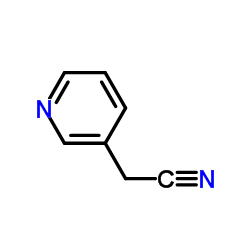
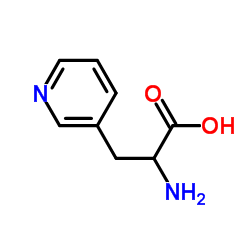

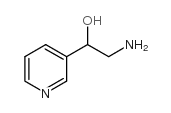
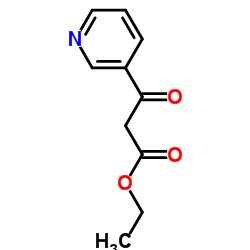
![2-hydroxyimino-3-oxo-3-[3]pyridyl-propionic acid ethyl ester结构式](https://image.chemsrc.com/caspic/303/61296-12-6.png)
